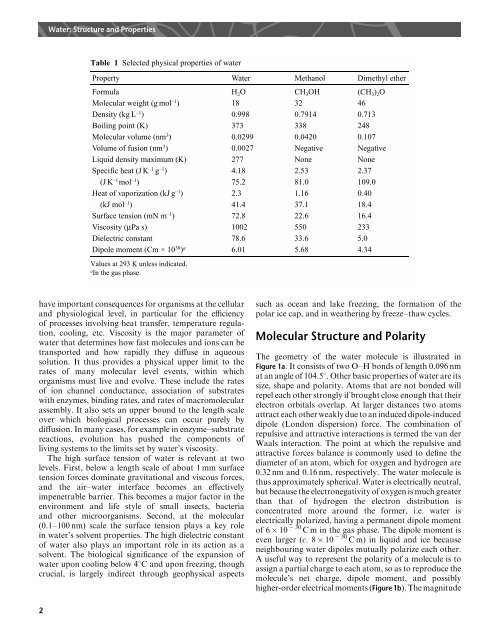Water: Structure and Properties - Kim Sharp - University of ...
Water: Structure and Properties - Kim Sharp - University of ...
Water: Structure and Properties - Kim Sharp - University of ...
Create successful ePaper yourself
Turn your PDF publications into a flip-book with our unique Google optimized e-Paper software.
<strong>Water</strong>: <strong>Structure</strong> <strong>and</strong> <strong>Properties</strong><br />
Table 1 Selected physical properties <strong>of</strong> water<br />
Property <strong>Water</strong> Methanol Dimethyl ether<br />
Formula H 2 O CH 3 OH (CH 3 ) 2 O<br />
Molecular weight (g mol –1 ) 18 32 46<br />
Density (kg L –1 ) 0.998 0.7914 0.713<br />
Boiling point (K) 373 338 248<br />
Molecular volume (nm 3 ) 0.0299 0.0420 0.107<br />
Volume <strong>of</strong> fusion (nm 3 ) 0.0027 Negative Negative<br />
Liquid density maximum (K) 277 None None<br />
Specific heat (J K –1 g –1 ) 4.18 2.53 2.37<br />
(J K –1 mol –1 ) 75.2 81.0 109.0<br />
Heat <strong>of</strong> vaporization (kJ g –1 ) 2.3 1.16 0.40<br />
(kJ mol –1 ) 41.4 37.1 18.4<br />
Surface tension (mN m –1 ) 72.8 22.6 16.4<br />
Viscosity (µPa s) 1002 550 233<br />
Dielectric constant 78.6 33.6 5.0<br />
Dipole moment (Cm × 10 30 ) a 6.01 5.68 4.34<br />
Values at 293 K unless indicated.<br />
a<br />
In the gas phase.<br />
have important consequences for organisms at the cellular<br />
<strong>and</strong> physiological level, in particular for the efficiency<br />
<strong>of</strong> processes involving heat transfer, temperature regulation,<br />
cooling, etc. Viscosity is the major parameter <strong>of</strong><br />
water that determines how fast molecules <strong>and</strong> ions can be<br />
transported <strong>and</strong> how rapidly they diffuse in aqueous<br />
solution. It thus provides a physical upper limit to the<br />
rates <strong>of</strong> many molecular level events, within which<br />
organisms must live <strong>and</strong> evolve. These include the rates<br />
<strong>of</strong> ion channel conductance, association <strong>of</strong> substrates<br />
with enzymes, binding rates, <strong>and</strong> rates <strong>of</strong> macromolecular<br />
assembly. It also sets an upper bound to the length scale<br />
over which biological processes can occur purely by<br />
diffusion. In many cases, for example in enzyme–substrate<br />
reactions, evolution has pushed the components <strong>of</strong><br />
living systems to the limits set by water’s viscosity.<br />
The high surface tension <strong>of</strong> water is relevant at two<br />
levels. First, below a length scale <strong>of</strong> about 1 mm surface<br />
tension forces dominate gravitational <strong>and</strong> viscous forces,<br />
<strong>and</strong> the air–water interface becomes an effectively<br />
impenetrable barrier. This becomes a major factor in the<br />
environment <strong>and</strong> life style <strong>of</strong> small insects, bacteria<br />
<strong>and</strong> other microorganisms. Second, at the molecular<br />
(0.1–100 nm) scale the surface tension plays a key role<br />
in water’s solvent properties. The high dielectric constant<br />
<strong>of</strong> water also plays an important role in its action as a<br />
solvent. The biological significance <strong>of</strong> the expansion <strong>of</strong><br />
water upon cooling below 48C <strong>and</strong> upon freezing, though<br />
crucial, is largely indirect through geophysical aspects<br />
such as ocean <strong>and</strong> lake freezing, the formation <strong>of</strong> the<br />
polar ice cap, <strong>and</strong> in weathering by freeze–thaw cycles.<br />
Molecular <strong>Structure</strong> <strong>and</strong> Polarity<br />
The geometry <strong>of</strong> the water molecule is illustrated in<br />
Figure 1a. It consists <strong>of</strong> two O–H bonds <strong>of</strong> length 0.096 nm<br />
at an angle <strong>of</strong> 104.58. Other basic properties <strong>of</strong> water are its<br />
size, shape <strong>and</strong> polarity. Atoms that are not bonded will<br />
repel each other strongly if brought close enough that their<br />
electron orbitals overlap. At larger distances two atoms<br />
attract each other weakly due to an induced dipole-induced<br />
dipole (London dispersion) force. The combination <strong>of</strong><br />
repulsive <strong>and</strong> attractive interactions is termed the van der<br />
Waals interaction. The point at which the repulsive <strong>and</strong><br />
attractive forces balance is commonly used to define the<br />
diameter <strong>of</strong> an atom, which for oxygen <strong>and</strong> hydrogen are<br />
0.32 nm <strong>and</strong> 0.16 nm, respectively. The water molecule is<br />
thus approximately spherical. <strong>Water</strong> is electrically neutral,<br />
but because the electronegativity <strong>of</strong> oxygen is much greater<br />
than that <strong>of</strong> hydrogen the electron distribution is<br />
concentrated more around the former, i.e. water is<br />
electrically polarized, having a permanent dipole moment<br />
<strong>of</strong> 6 10 2 30 C m in the gas phase. The dipole moment is<br />
even larger (c. 8 10 2 30 C m) in liquid <strong>and</strong> ice because<br />
neighbouring water dipoles mutually polarize each other.<br />
A useful way to represent the polarity <strong>of</strong> a molecule is to<br />
assign a partial charge to each atom, so as to reproduce the<br />
molecule’s net charge, dipole moment, <strong>and</strong> possibly<br />
higher-order electrical moments (Figure 1b). The magnitude<br />
2



